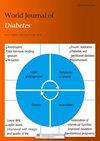Metabolic disorders in prediabetes: From mechanisms to therapeutic management.
IF 4.6
3区 医学
Q1 ENDOCRINOLOGY & METABOLISM
引用次数: 0
Abstract
Diabetes, one of the world's top ten diseases, is known for its high mortality and complication rates and low cure rate. Prediabetes precedes the onset of diabetes, during which effective treatment can reduce diabetes risk. Prediabetes risk factors include high-calorie and high-fat diets, sedentary lifestyles, and stress. Consequences may include considerable damage to vital organs, including the retina, liver, and kidneys. Interventions for treating prediabetes include a healthy lifestyle diet and pharmacological treatments. However, while these options are effective in the short term, they may fail due to the difficulty of long-term implementation. Medications may also be used to treat prediabetes. This review examines prediabetic treatments, particularly metformin, glucagon-like peptide-1 receptor agonists, sodium glucose cotransporter 2 inhibitors, vitamin D, and herbal medicines. Given the remarkable impact of prediabetes on the progression of diabetes mellitus, it is crucial to intervene promptly and effectively to regulate prediabetes. However, the current body of research on prediabetes is limited, and there is considerable confusion surrounding clinically relevant medications. This paper aims to provide a comprehensive summary of the pathogenesis of pre-diabetes mellitus and its associated therapeutic drugs. The ultimate goal is to facilitate the clinical utilization of medications and achieve efficient and timely control of diabetes mellitus.糖尿病前期的代谢紊乱:从机制到治疗管理。
糖尿病是世界十大疾病之一,以死亡率高、并发症多、治愈率低而闻名。糖尿病前期是糖尿病发病的前兆,在此期间,有效的治疗可以降低糖尿病风险。糖尿病前期的风险因素包括高热量和高脂肪饮食、久坐不动的生活方式和压力。其后果可能包括对视网膜、肝脏和肾脏等重要器官造成严重损害。治疗糖尿病前期的干预措施包括健康生活饮食和药物治疗。不过,虽然这些方法在短期内有效,但由于难以长期实施,可能会失败。药物也可用于治疗糖尿病前期。本综述探讨了糖尿病前期的治疗方法,尤其是二甲双胍、胰高血糖素样肽-1 受体激动剂、钠葡萄糖共转运体 2 抑制剂、维生素 D 和草药。鉴于糖尿病前期对糖尿病进展的显著影响,及时有效地干预以控制糖尿病前期至关重要。然而,目前关于糖尿病前期的研究还很有限,临床相关药物也相当混乱。本文旨在全面总结糖尿病前期的发病机制及其相关治疗药物。最终目的是方便临床用药,及时有效地控制糖尿病。
本文章由计算机程序翻译,如有差异,请以英文原文为准。
求助全文
约1分钟内获得全文
求助全文
来源期刊

World Journal of Diabetes
ENDOCRINOLOGY & METABOLISM-
自引率
2.40%
发文量
909
期刊介绍:
The WJD is a high-quality, peer reviewed, open-access journal. The primary task of WJD is to rapidly publish high-quality original articles, reviews, editorials, and case reports in the field of diabetes. In order to promote productive academic communication, the peer review process for the WJD is transparent; to this end, all published manuscripts are accompanied by the anonymized reviewers’ comments as well as the authors’ responses. The primary aims of the WJD are to improve diagnostic, therapeutic and preventive modalities and the skills of clinicians and to guide clinical practice in diabetes. Scope: Diabetes Complications, Experimental Diabetes Mellitus, Type 1 Diabetes Mellitus, Type 2 Diabetes Mellitus, Diabetes, Gestational, Diabetic Angiopathies, Diabetic Cardiomyopathies, Diabetic Coma, Diabetic Ketoacidosis, Diabetic Nephropathies, Diabetic Neuropathies, Donohue Syndrome, Fetal Macrosomia, and Prediabetic State.
 求助内容:
求助内容: 应助结果提醒方式:
应助结果提醒方式:


